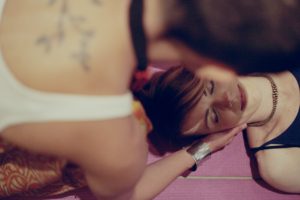Principles of Neuromuscular Therapy
By Laurence Layne, LMT, CNMT


Call for an appointment 904-826-1965
Neuromuscular Therapy (NMT) is considered part of massage therapy, and the greatest number of NMT practitioners are massage therapists. By outlining the various principles and practices, this article will serve to help health professionals, therapists, doctors, students, and others to understand the level of study and proficiency needed to perform Neuromuscular Therapy.
The primary goals of Neuromuscular Therapy are:
- Pain Relief
- Restoration of Proper Biomechanics
- Improved Whole Body Function
Neuromuscular Therapy evaluation consists of:
- Postural Analysis: sitting, standing, prone, and supine
- Analysis of Cranial and Pelvic anatomical structures
- Gait Analysis
- Analysis of Flexibility and Biomechanics
- Palpation of ‘Soft Tissues
Soft Tissues of the Body:
- Muscles
- Tendons
- Ligaments
- Fascia
Neuromuscular Therapy treatment consists of:
- Soft Tissue Manipulation
- Stabilization & Mobilization of Joints (Soft Tissues)
- Massage
- Myofascial Stretching
- Muscle Energy Technique
- Hydrotherapy Nutritional Supplementation
- Health Education
Types of massage used in Neuromuscular Therapy include:
- Deep Tissue Massage
- Cross Fiber Friction
- Pincer Massage
- Ischemic Compression
- Traction &l Stretching
- Range of Motion
- Skin Rolling
- Tapotement
- Visceral Massage
Unique Components of Neuromuscular Therapy:
- Treats origin, insertion, and belly of muscles
- Uses pressure bars, known as “T” bars for instrument assisted massage
- Uses bones as handles to release tight, constricted muscles
- Utilizes principle of “structural homeostasis” for pain relief
- Uses neurological laws as principles of treatment
- Integrates wholistic thinking as means to problem solving
- Integrates somatic movement therapy into treatment regimen
- Philosophy similar to Chiropractic but adapted to soft tissues
Neurological Laws used in Neuromuscular Therapy:
- Law of Facilitation
- Davis’ Law
- Hilton’s Law
- Head’s Law
- Hooke’s Law
- Sherrington’s Law
- Wolff’s Law
- Arndt-Schultz Law
- Pfluger’s Laws
Neurological Concepts:
- Pathological Reflex Arc
- Spasm
- Dermatones
- Autonomic Nervous System
- GAS and LAS
Muscle Energy Principles in Neuromuscular Therapy
- Post Isometric Relaxation
- Reciprocal Inhibition
- Eccentric Contractions
- Concentric Contractions
Biomechanical Principles in Neuromuscular Therapy
- Structural Homeostasis
- Righting Reflexes
- Fryette’s Laws
- Law of Motion
- Proprioception
Seven Factors or Principles of Chronic Pain in Neuromuscular Therapy:
- Ischemia
- Postural Distortion
- Trigger Points
- Nerve Entrapment/INerve Compression
- Biomechanical Dysfunction
- Nutritional Deficiencies
- Emotional Wellbeing
Five Stages of Rehabilitation in Neuromuscular Therapy:
- Pain Relief
- Restore Biomechanics
- Restore Flexibility
- Rebuild Strength
- Build Endurance
Neuromuscular Components of Scoliosis Treatment
- Find a Cave—Go Into it
- Find a Tilt—Straighten It
- Find a Rotation—Right It
Notes:
While compiling this article it became clear to me that other practitioners would make different choices on which principles should be included in a “list of principles” for Neuromuscular Therapy. The teaching of NMT has evolved over the last three decades of its existence, along with the bodywork culture and the understanding of the teachers themselves.
Early seminar manuals list Pfluger’s Laws, while later ones do not. Factors in Chronic Pain originally numbered four, later became five, then six, and ultimately seven if one counted different ways teachers explained them. European Neuromuscular Technique includes Muscle Energy, and although the American version originally did not, it was added in St. John Seminar #8 Advanced Cervical and Cranial Stabilization & Atlas-Axis Mobilization.
More complex descriptions of “soft tissue manipulation” were listed in Judith DeLany’s certification manual and due to scope of this article had to be left out. The same goes for the “torquing” method of myofascial release described by Paul St. John, and other methods. I decided to include “improved whole body function” as a goal of NMT because that’s how I view my therapy outcomes, but I am sure many other therapists would agree with that choice. Since these type of editorial choices were in play, this list is not “complete,” but should give a good idea of what Neuromuscular Therapy is about.
Nutritional supplementation is a therapeutic choice not used by every therapist, but a topic most therapists are questioned about. The References below list several books which cover soft tissue healing through supplementation.
Neuromuscular Therapy is primarily a soft tissue therapy, and even though terms like joint mobilization and stabilization are used here, the techniques listed belong firmly within the scope of practice of a massage therapist, athletic trainer, physical therapist, and other certified or licensed hands-on healers. High Velocity Low Amplitude (HVLA) adjustments are not used.
References:
St. John Neuromuscular Therapy Seminar Manuals 1–5, by Paul St. John, LMT, Largo, Florida, 1990–1994.
St. John Neuromuscular Therapy Seminar Manual 8 A/B, by Paul St. John, LMT, Pinellas Park, Florida, 2004.
Neuromuscular Therapy, American Version, Certification Manual, Vol. 1–5, Judith (Walker) DeLany, LMT, St. Petersburg, Florida, 2001, 2002.
Modern Neuromuscular Techniques, Leon Chaitow, DO, Judith (Walker) DeLany, LMT, Churchill Livingstone, 1996.
Clinical Application of Neuromuscular Techniques, Vol. 1–The Upper Body, Leon Chaitow, DO & Judith Walker DeLany, Churchill Livingstone, 2001.
Myofascial Pain and Dysfunction, Vol. 1. Upper Half of Body, David G. Simons, MD, Janet G. Travell, MD, and Lois S. Simons, PT, Williams & Wilkins, 1999.
